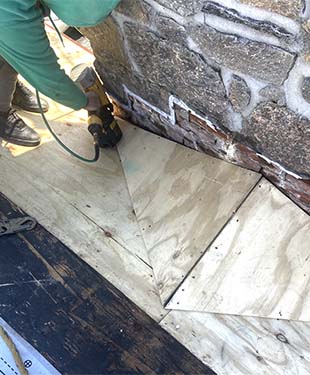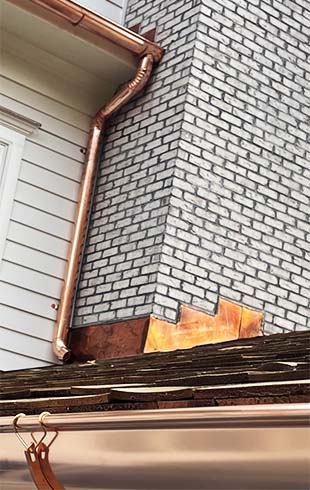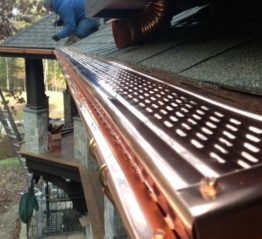Roof & Chimney Flashing Fairfield County: A Guide

Chimney & Roof Flashing Repair, Installation, and Maintenance: a Comprehensive Guide
“In Fairfield County, we’re lucky to enjoy all four seasons, but that also means our homes take a beating from snow, rain, and everything in between. One of the unsung heroes in keeping your home safe and dry? Roof flashing, especially around chimneys. When it’s installed right, flashing acts like a shield, protecting your roof and home. Roof flashing might feel like a small detail, but chimney flashing makes a big difference in standing up to our area’s unpredictable weather.”
Roof flashing—whether on your roof or chimney—seals gaps to keep water out and protect your home from leaks and damage. Where two angles of your roof meet, or where different materials come together, flashing is typically used to prevent water from seeping in.
Chimney Flashing: Types and Techniques
Chimney flashing comes in many shapes and styles—there’s no one-size-fits-all solution. Each piece is custom-designed and installed to fit the specific roof or chimney it’s crafted for. While all types of flashing serve the same essential purpose—to prevent water from seeping into vulnerable areas—they are tailored and installed differently to meet the unique demands of each location, such as where a chimney meets the roof or where dormers reconnect with the main roof plane. Let’s take a closer look at the various types of flashing that safeguard our homes.
Chimney Flashing Types
There are several popular types an styles of Chimney flashing, each designed to address specific but common roof vulnerabilities. Here’s a breakdown of common flashing types used on homes throughout Connecticut, their purposes, and examples of when they’re used:
-
Step Flashing
Consists of layers of rectangular pieces of roof flashing installed in a step-like pattern. Each piece overlapping the other with a shingle course and works as part of the roofing system to direct water safely down the roof.
Step flashing is typically used where the side of a chimney meets the sloped portion of a roof. For example, on a gable roof, step flashing is installed to guide water along the shingles, preventing it from pooling near the chimney base and causing leaks.
Base Flashing
Installed around the base of the chimney and is often paired with step flashing. It typically consists of larger, angled pieces of the flashing material, often copper and is designed to provide additional protection where the roof meets the chimney.
Base flashing is critical for chimneys that penetrate steeply sloped roofs. It helps to direct water away from the chimney base and into the roof’s drainage system.
Cap Flashing
The topmost layer of flashing, sealing the upper portion of the chimney to block water infiltration at the roofline.
Cap flashing is typically installed after the step and counter flashing, completing the system. It’s especially useful for protecting chimneys that have undergone repairs or where the masonry has shown signs of wear over time.
-
Counter Flashing
Counter flashing is installed above step flashing and is embedded directly into the masonry of the chimney. It overlaps the step flashing to create a secondary barrier that prevents water from infiltrating the chimney’s vulnerable seams.
Counter flashing is used when the chimney’s structure extends out of the roofline. For instance, on brick chimneys, counter flashing is embedded into the mortar joints, providing long-lasting protection against water that might bypass step flashing.
The Critical Role of Crickets in Chimney Flashing
Crickets stand as the unsung heroes of chimney flashing, especially crucial when a chimney’s width or the roof’s slope significantly increases water diversion needs. Their role? To prevent water accumulation by channeling it away from the chimney, ensuring the roof’s drainage system efficiently manages it.
When is a Cricket Necessary?
- Chimney Width: Codes often mandate crickets for chimneys exceeding 30 inches in width due to their propensity to collect water.
- Roof Slope: Steeper slopes introduce greater volumes of water towards the chimney, necessitating effective diversion mechanisms.
- Past Water Issues: A history of leaks or damage indicates a cricket’s installation could prevent recurrence.
- Dedicated Cricket Design and Construction: We meticulously design and construct crickets to complement your roof’s architecture, ensuring effective water diversion.
George’s Seamless Gutters: Your Partner in Flashing Excellence Our expertise extends into the precise assessment, design, and installation of comprehensive chimney flashing solutions, including the strategic employment of crickets. Our methodical approach ensures your home receives the utmost protection:
- Customized Assessments and Solutions: Tailoring our services to meet your roof’s unique challenges, we offer specialized designs for effective water management.
- Expert Installation: Our proficiency encompasses the seamless installation of step, counter, base, and cap flashing, each element working cohesively for optimal protection.
- Dedicated Cricket Design and Construction: We meticulously design and construct crickets to complement your roof’s architecture, ensuring effective water diversion.
Ensuring a Dry and Secure Living EnvironmentA proactive approach to gutter maintenance, including professional cleaning before winter and expert hard freeze testing, is essential to safeguard your home from the threat of ice dams. By entrusting George’s Seamless Gutter with the care of your gutters, you can minimize the risk of ice dams and the potential damage they can cause.
Contact us for a detailed consultation. Entrust your home to our capable hands and secure a roofing system that’s not only water-resistant but meticulously managed to withstand the test of Fairfield County’s diverse weather conditions.
Give us a call at 203.258.4759 or email us at info@allwestchestergutters.com.


















